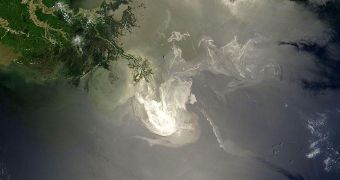The current ecological disaster unfolding in the Gulf of Mexico is the largest in the history of the United States, a top official said recently. Carol Browner, the energy advisor for the White House, explained that the amount of oil that leaked into the waters of the Gulf now exceeds the amounts spilled by the Exxon Valdez tanker significantly. Until now, the latter was the worst eco-disaster in the country. But the bad news doesn't stop here. According to representatives of British Petroleum (BP), the company that operated the drilling rig, it would appear that all efforts to contain the leak have thus far failed, the BBC News reports.
The accident began unfolding on April 20, when the semi-submersible drilling rig Deepwater Horizon exploded, 50 miles off the coast of Louisiana, killing 11 workers. While the rest of the crew was being rescued, the rig sunk on April 22, allowing for thousands of barrels of oil to spill in the Gulf every day. Though initial estimates had placed the scale of the flow to 1,000 barrels per day, it was quickly upped to 5,000 barrels and then to anywhere between 12,000 and 19,000 barrels daily, according to the most recent estimate. Though federal authorities stepped in fairly soon after the drilling rig sunk, their intervention had little effect in containing the spill.
Unlike the Exxon Valdez incident, where the oil slick was contained by land, the Gulf of Mexico slick is in the open. Due to the fact that the rig was operating at more than a mile in depth, underwater blobs of oil have begun forming, and scientists now find it hard to locate them, and keep them under observation. There is a very real danger that large amounts of crude will make their way in the Loop Current, a deep-water current that runs east, towards Florida. The Current also ties to the Gulf Stream, the north-Atlantic conveyor belt that takes water to the East Coast of the US, and then to Europe.
Efforts are currently underway to mitigate the leak, with dispersant being spread across the surface of the water from numerous planes. Various other containment measures have also been set in place, but thus far they only had limited efficiency. BP officials continuously announce new approaches of sealing the blown wellheads, only to come out days after to report on yet another failure. Meantime, local communities blame both the company and federal authorities for the mishap, expressing their dissatisfaction with the clean-up effort through street signs and various other means.

 14 DAY TRIAL //
14 DAY TRIAL //